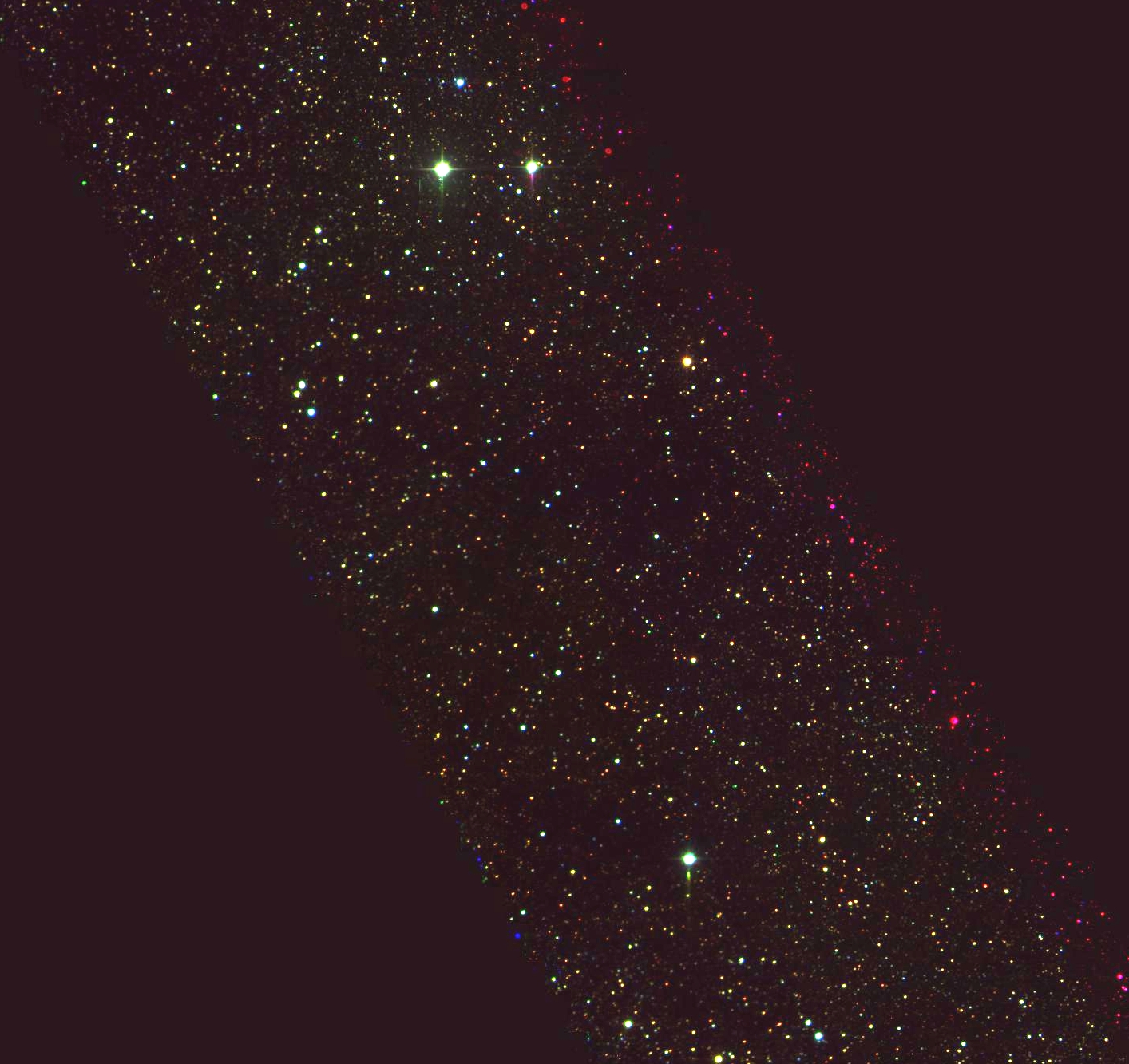
Abstract
Between 1998 and 2003 we carried out a series of observing campaigns using the 1.23m and 2.2m telescopes on Calar Alto with the goal of searching for distant late-type supergiants in the inner regions of the disk of our Galaxy. The observations obtained in Calar Alto have allowed the identification and spectroscopic confirmation of nearly 200 cool, luminous stars for which medium-resolution spectroscopy has been obtained at the ESO New Technology Telescope on La Silla, Chile. No less than 18 of these stars turn out to be confirmed as very likely supergiants, and another 9 are strong candidates. The rest of the cool stars are red giants and large-amplitude variables. The size of the sample and the medium-resolution spectra allow us to compare the characteristics of inner Galaxy giants and supergiants with those of similar stars in the solar neighbourhood. Interestingly, we find that the spectral features of giants and supergiants in the inner Galaxy have noticeable differences with respect to local ones, and that systematic differences suspected between local and bulge giants also apply between local and inner-Galaxy supergiants. In this regard, supergiants in the inner Galaxy more closely resemble the supergiants in the galactic center than those in the local neighbourhood. This result cautions against the modeling of central starbursts in other galaxies using spectral libraries built from solar neighbourhood templates.
Introduction
The inner regions of galactic disks contain a wealth of information on the structure, dynamics, and history of spiral galaxies. While the central parsecs of a galaxy are often dominated by intense starburst activity or by the action of a supermassive black hole on its surroundings, like in our own Galaxy (e.g. Melia & Falcke 2001), the inner few kiloparsecs provide numerous observational tracers reflecting the consequences of important mechanisms such as the presence of bars that feed gas to the central engine or rings, or enhanced star formation associated to the large-scale gasdynamical perturbations driven by resonances of the potential. They also contain a record of the metal enrichment of the galactic disk, which in turn given essential clues on its build-up process (Chiappini et al. 2001).
An additional reason to be interested in the inner regions of our own Galaxy is the accessibility of individual stars that can be observed and analyzed in detail, and the subsequent possibility of using their spectra as templates for the interpretation of the integrated spectra of much more distant, unresolved stellar populations. In this regard, one of the main tools used nowadays for deriving the recent star formation history of active galactic nuclei (AGNs) and central starbursts is the definition of appropriate spectrophotometric indices in the near-infrared, where most of the luminosity is contributed by very young, massive supergiants and older, evolved Red Giant Branch (RGB) and Assymptotic Giant Branch (AGB) stars. In principle suitably defined indices allow one to disentangle the relative contributions of both populations and to assess the evolutionary status of the more evolved population. In practice, such exercise critically depends on the choice of templates of the stellar spectra contributing to the luminosity, be it by using a library of actual stellar spectra, or by relying on model spectra produced by stellar evolution models.
The identification of a sample of late-type stars, and especially supergiants, in the direction of the inner galactic disk can address many of the points noted above. Due to the short lifetimes of their massive progenitor stars late-type supergiants highlight regions of recent star formation, and their large-scale distribution can be used to map current star formation across the galactic disk. Their high luminosities in the near-infrared, where extinction is much lower than in the visible, place late-type supergiants anywhere in the Galaxy within easy reach of medium-sized telescopes and allow high S/N spectroscopy to be obtained. Their deep CO bandheads make them easily identifiable by means of narrow-band imaging. Finally, their distribution at different distances with respect to the galactic center and the well-established metallicity gradient in the galactic disk make it possible to sample the effects of a range of supersolar metallicities on the spectral features.
The project described here combines two campaigns of observations at Calar Alto in which we imaged through narrow-band filters a narrow strip, 15 degrees long, along the galactic equator through narrow-band filters that sample the drop in flux due to the first CO(2,0) bandhead at 2.293 microns in cool stars. This was followed by low resolution spectroscopy in both Calar Alto and La Silla to confirm the cool temperatures of the candidates detected via imaging, including high S/N spectroscopy that enables us to examine the behavior of the molecular and atomic bands seen in the infrared H and K bands. Here we present and discuss the highlights of our results, and refer the reader to our paper (Comerón et al. 2004) for a more complete and detailed presentation.
Imaging observations
The first set of imaging observations was obtained in 1998 using MAGIC
at the 1.23m telescope. A second set of observations, obtained in 2001
with the same telescope and instrument, completed the imaging survey
covering three parallel strips of 15 degrees length between galactic
longitudes 6 and 21 degrees, and galactic latitudes centered on
b = -4', 0, +4', each strip being approximately 5' wide.
Each strip was imaged through the J, H, CO continuum and CO on-band
filters, down to completeness limits J=15.5, H=15, CO continuum (supposed
to be well approximated by K) = 13.0. Of more than 435,000 stars detected,
over 23,000 had their CO index (defined as the magnitude difference
between the on- and off-band magnitudes in the proximity of the CO(2,0)
bandhead) measured with an accuracy better than 0.1 mag. Due to the narrow
CO on-band filter this accuracy was limited to stars brighter than
K=10.0, approximately. The rather complicated process of data reduction
and calibration of the imaging observations has been described
step-by-step by Comerón et al. (2004). We show in
Figure 1 a sample fragment of a color composite of
the mosaic formed by combining the individual dark-subtracted,
flat-fielded, and bias-subtracted images that compose two parallel
strips.

Spectroscopic observations and spectrophotometric
indices
Stars were selected for subsequent spectroscopy on the basis of the
extreme value of their CO indices, indicative of a deep drop of flux at
2.293 microns caused by strong CO absorption bands. A first set of
spectroscopic observations were obtained in a number of runs between
2000 and 2003 using MAGIC the 1.23m and 2.2m telescopes, as shown in
Figure 2.
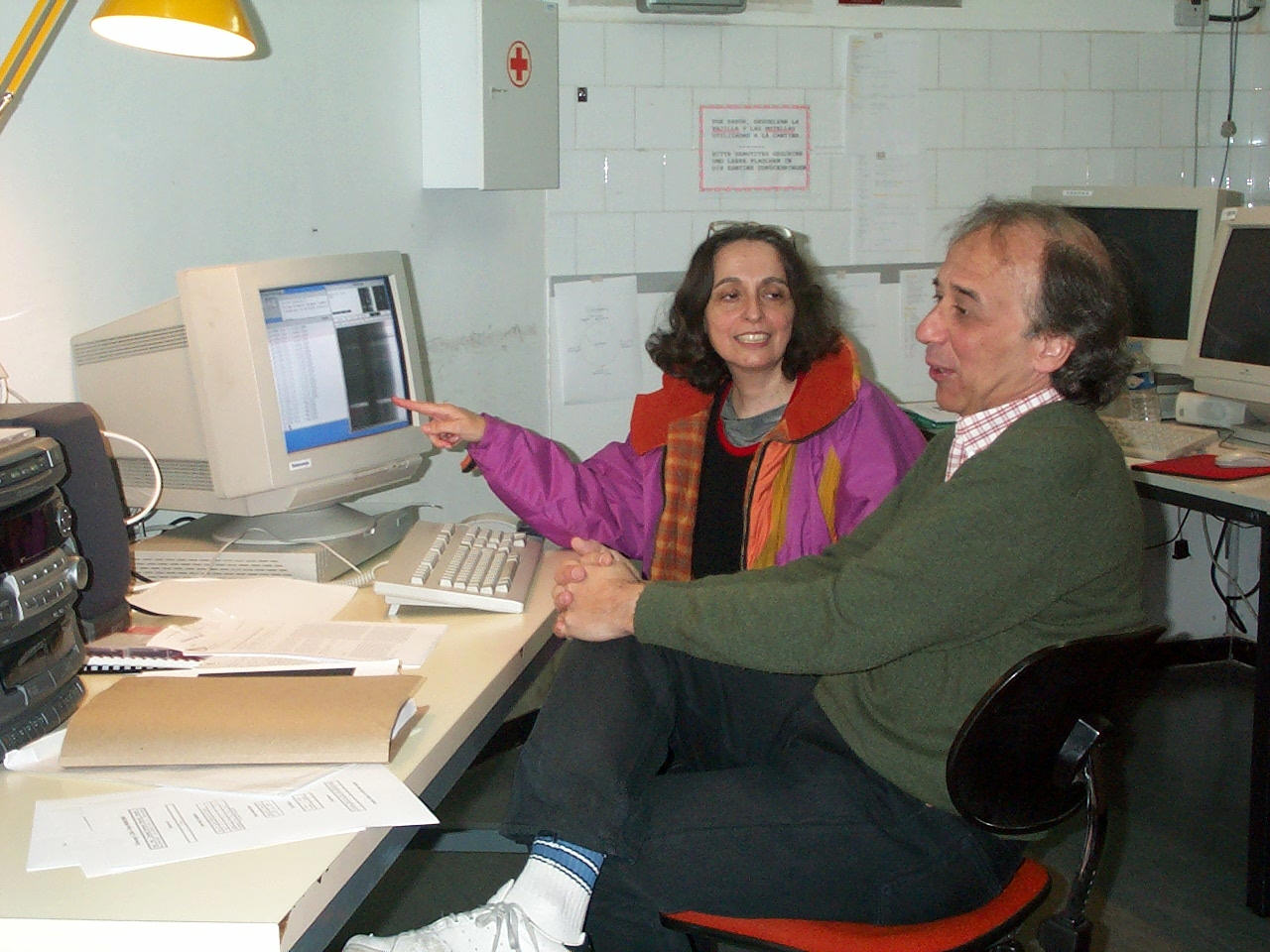
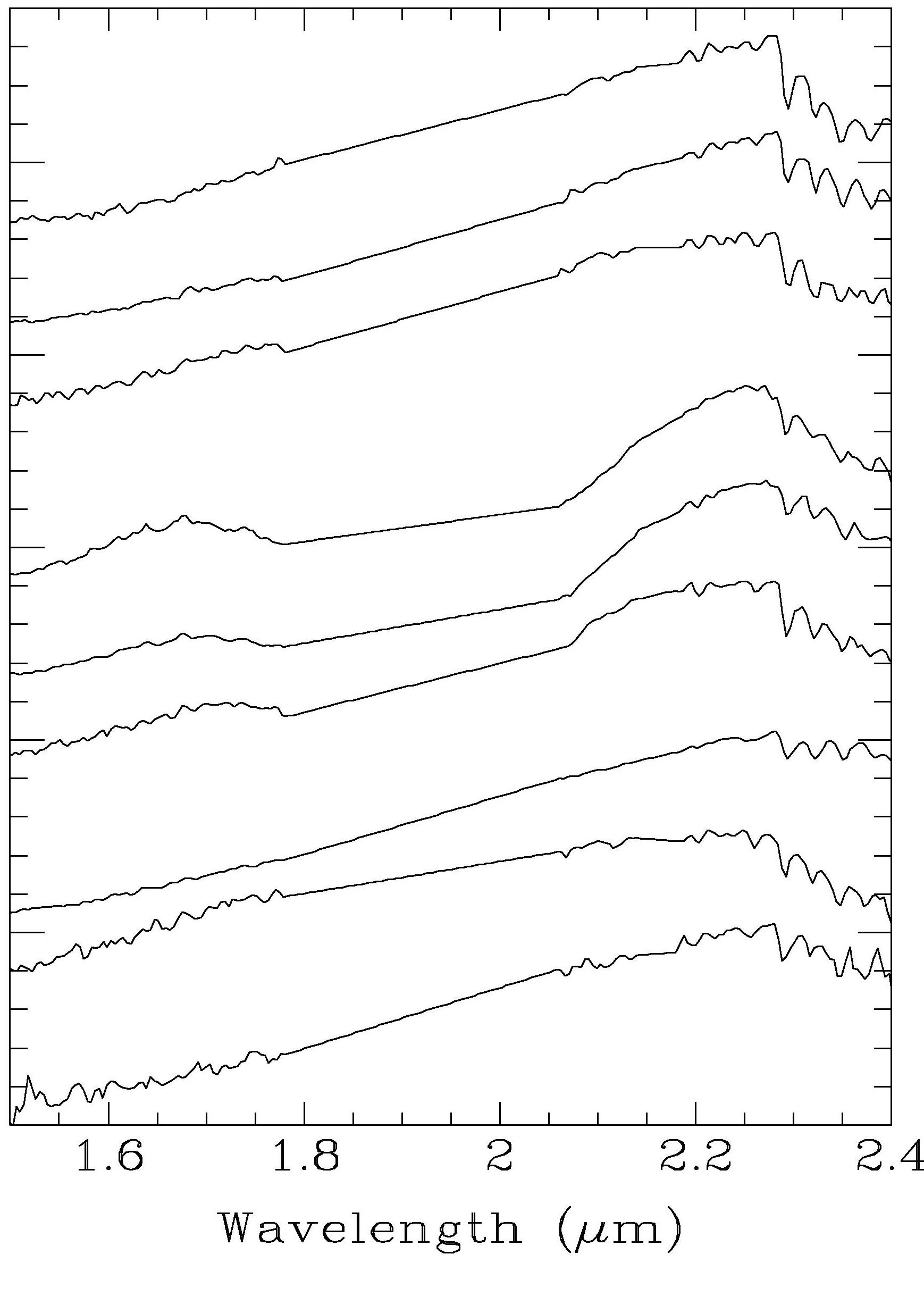
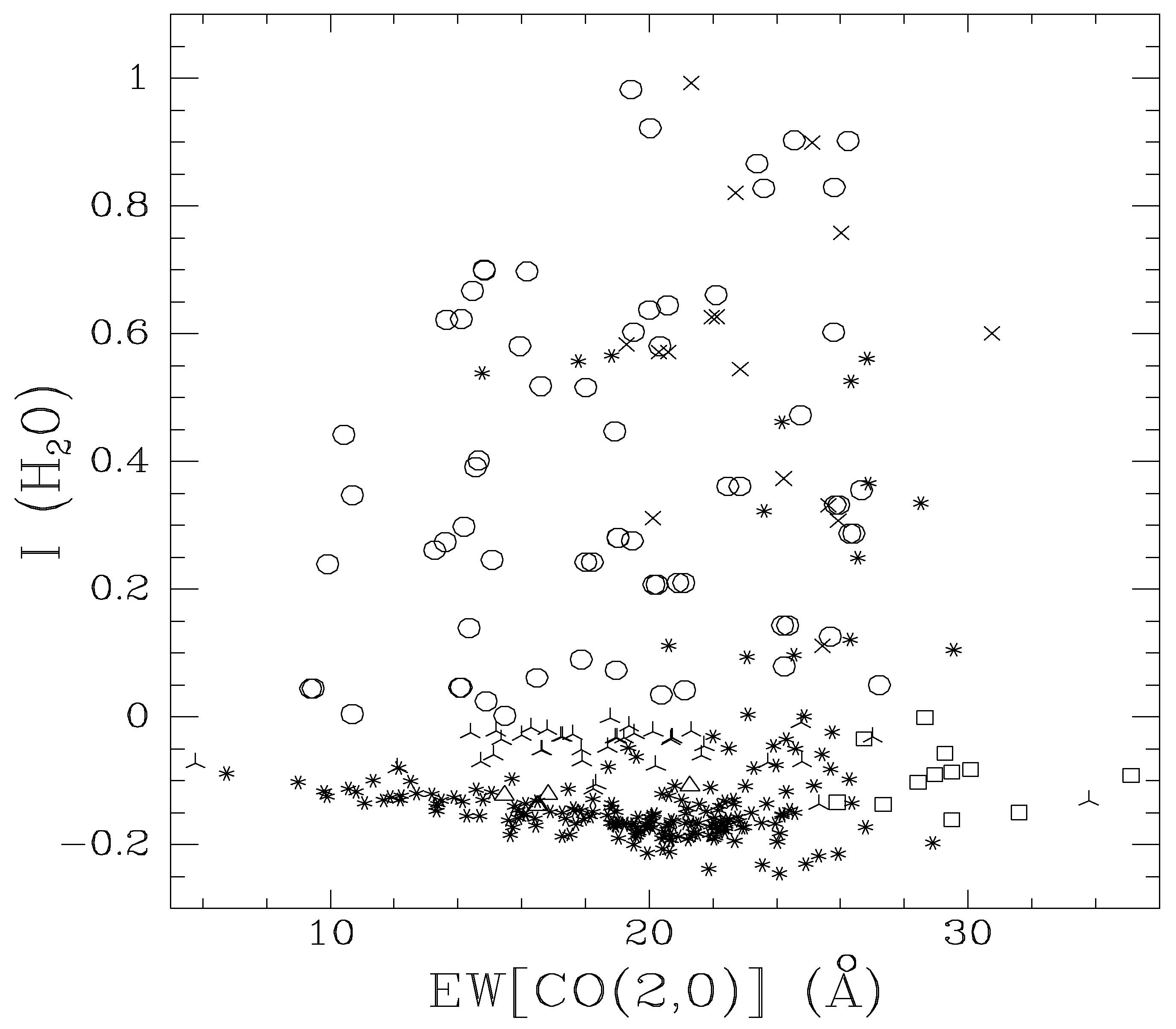
Supergiants in our sample
A first hint that supergiants are actually represented in our sample,
albeit not dominating it, comes from the 2MASS color-magnitude diagram
of all our stars, plotted in Figure 5. The AGB stars
indentified on the basis of their strong water band wings occupy a band
in this diagram whose tilt is due to the effects of both distance and
extinction, since more distant stars are expected to be generally more
reddened. The absolute K-band magnitudes of AGB stars are expected to
lie between -6.4 and -8.2 (Knapp et al. 2003), thus being brighter than
most RGB stars and overlapping with the luminosities of supergiants
(from which they are otherwise well separated spectroscopically). The
band that they define in the (H-K, K) diagram thus marks the region
where we expect to find also the supergiants that there may exist in our
sample. And indeed, it turns out that the region is not devoided of
objects from our sample. It is remarkable in particular the existence of
a clump centered near (H-K) = 2.4, K = 9.5, of extremely red stars with
weak or absent water absorption in their spectra, which may be distant,
highly reddened, bright supergiants.
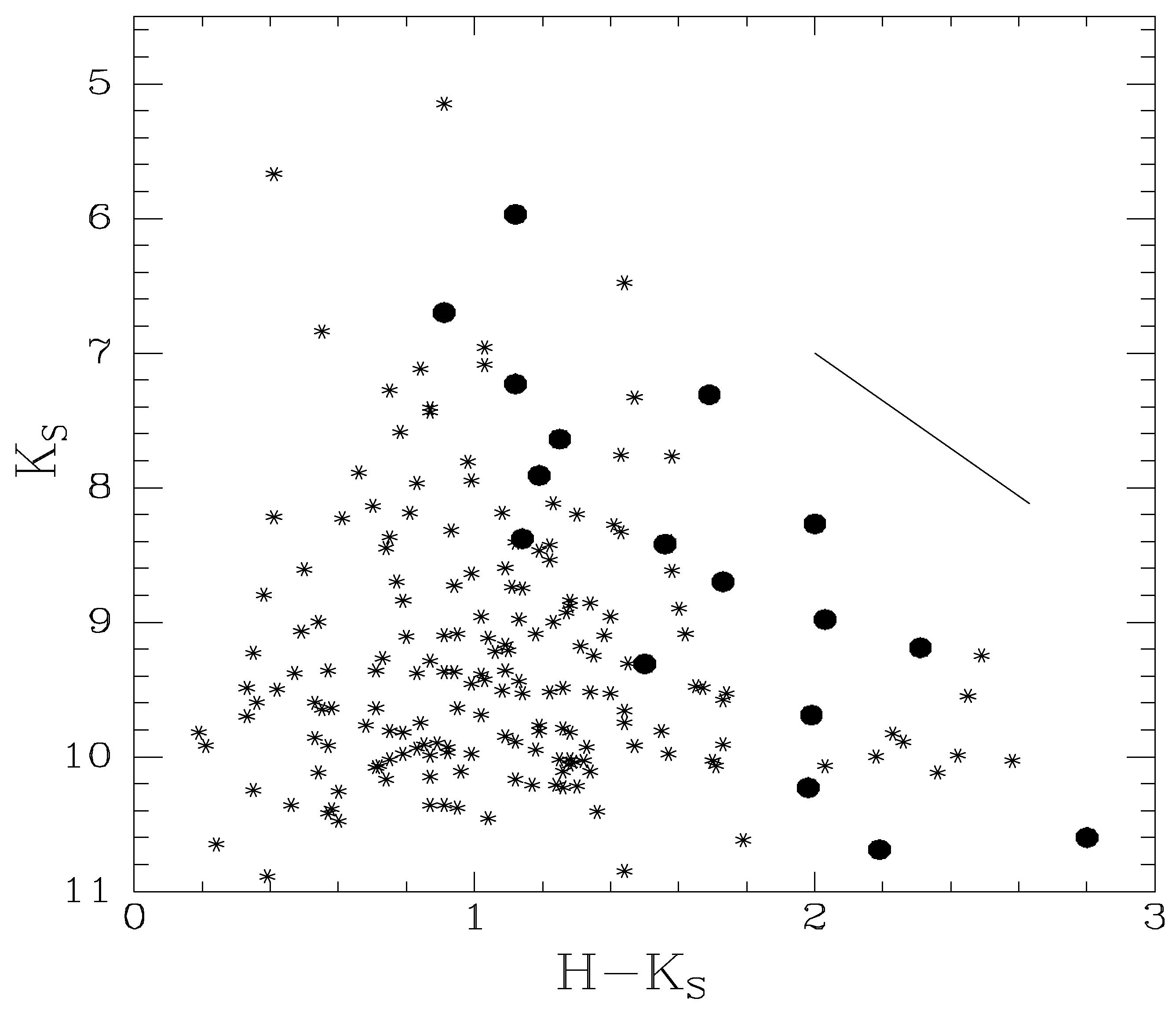
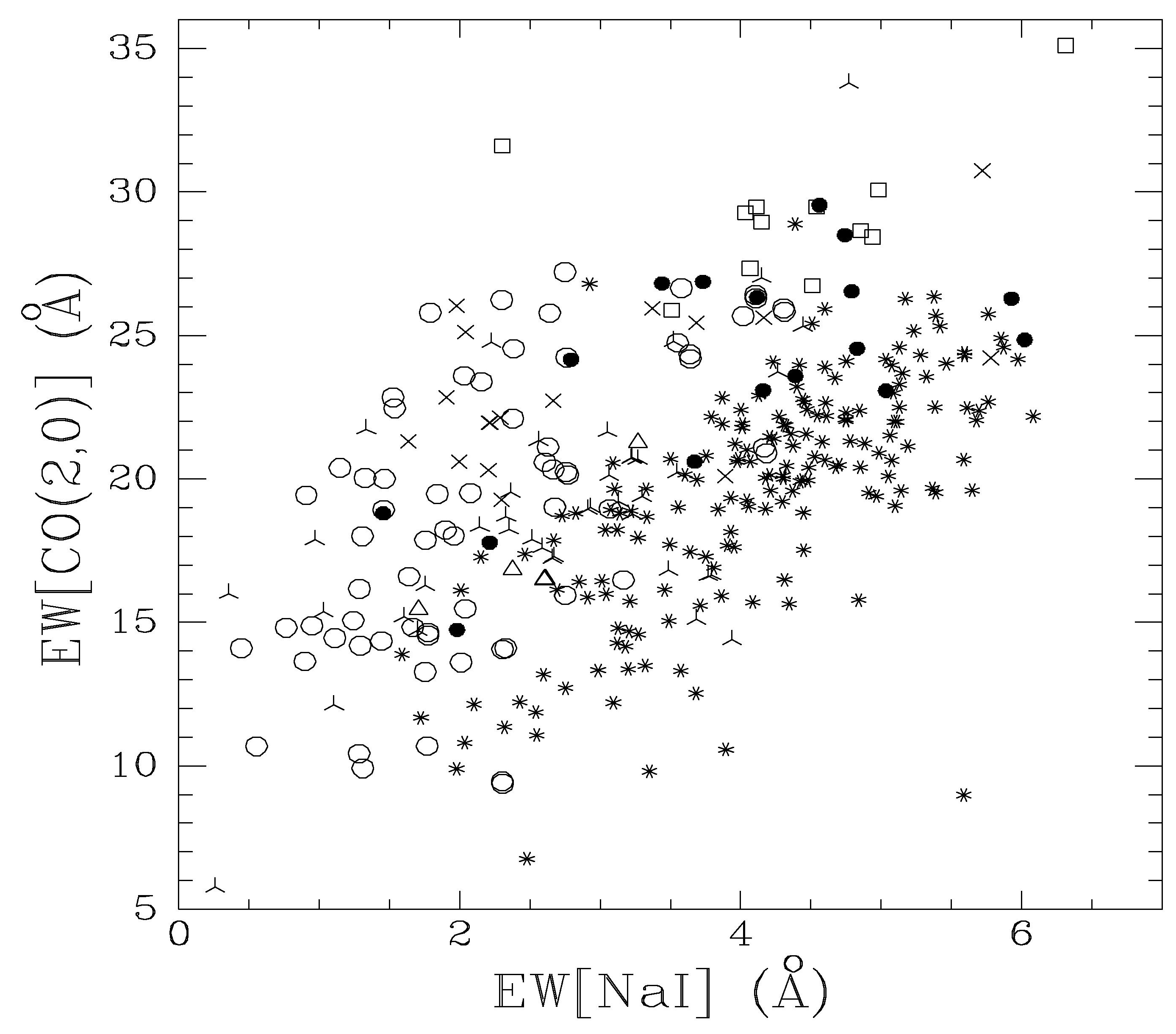
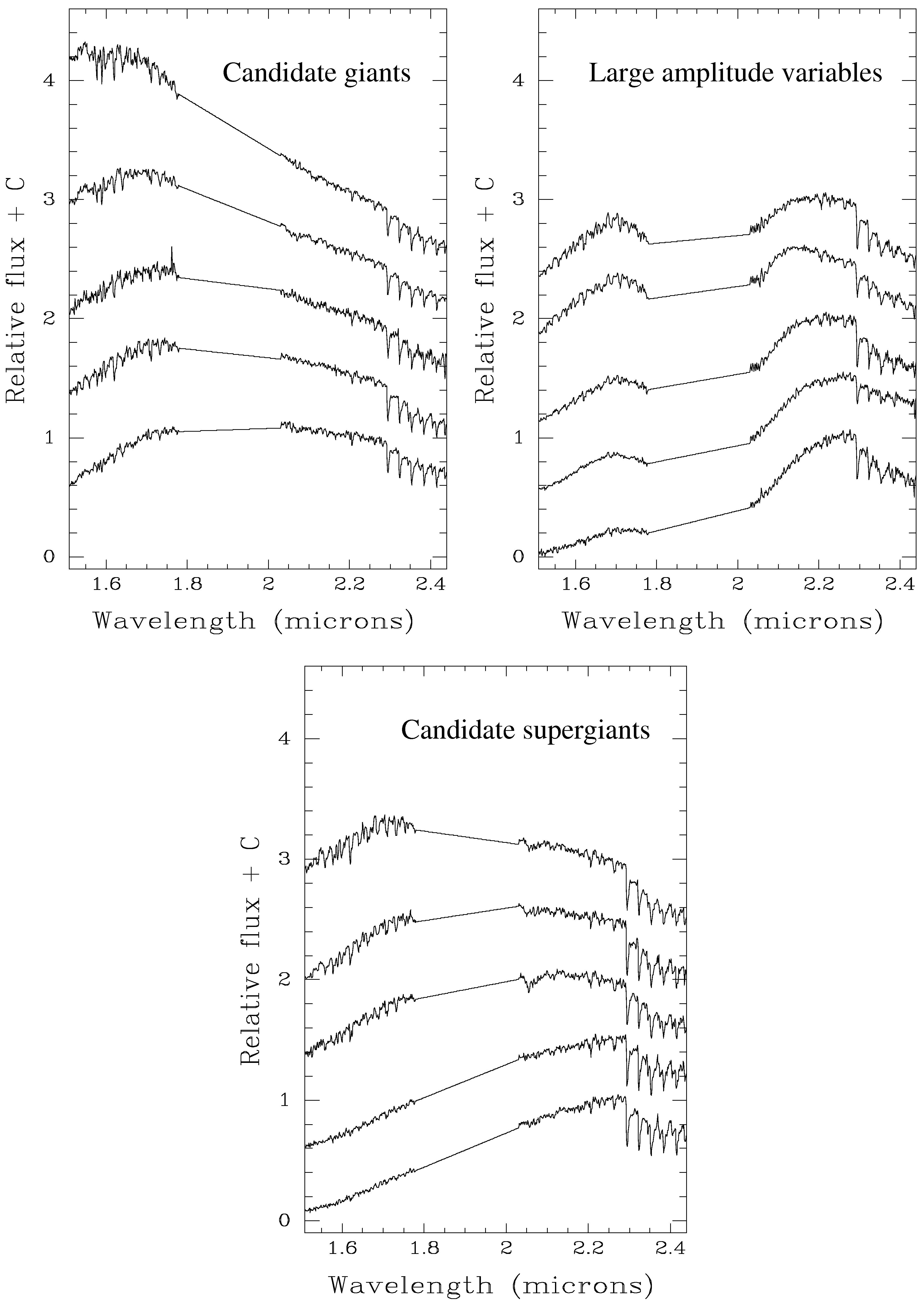
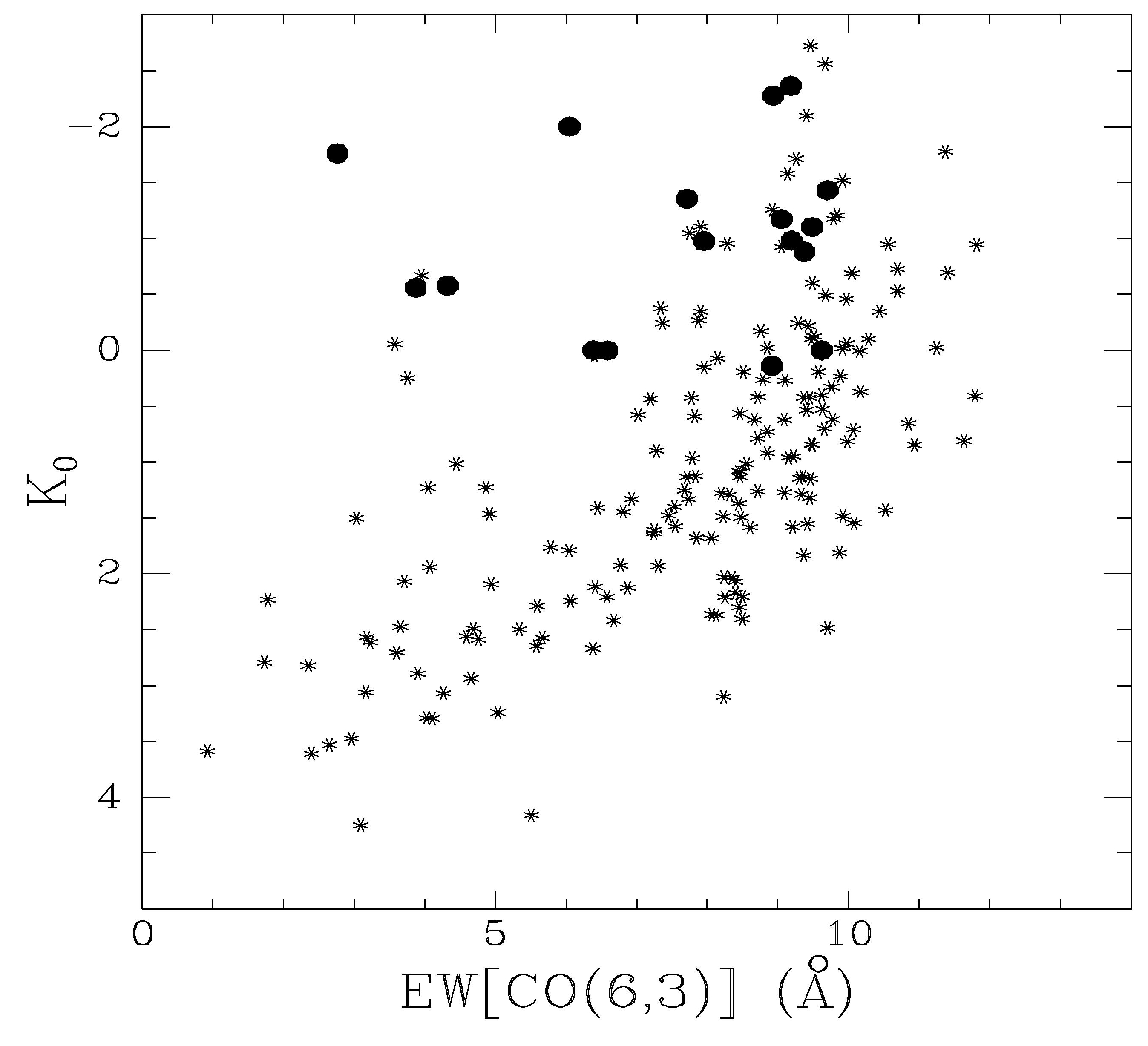
Rather than using the CO(2,0) bandhead as a strict criterion for the identification of supergiants in our sample using thresholds based on the supergiants of the solar neighbourhood (which would in fact exclude the galactic center supergiants), we have preferred a combination of criteria combining different spectroscopic features and photometric properties. We thus select likely supergiants as those stars having:
Why are cool stars in the inner Galaxy different?
As we have already stressed the characteristics of the cool stars of our sample of the inner Galaxy, including those that we identify as the best supergiant candidates, are markedly different from those of the solar neighbourhood. Closer analogs are found among galactic bulge giants and galactic center giants and supergiants. Interestingly, detailed chemical composition studies of the latter carried out by Carr et al. (2000) show that the different spectral characteristics of galactic center giants are not due to a metallicity significantly different from the solar value, but rather to altered surface abundances of CNO-processed material indicating a deeper penetration of the convective zone. This not only explains the weaker CO bands due to the reduced surface abundance of carbon and oxigen, but also the stronger atomic features given the important and eventually dominant contribution of CN bands to them when observed at low-to-medium resolution.
Having the constraint of a solar metallicity for the galactic center supergiants, the altered CNO abundances are attributed by Carr et al. (2000) to higher rotation velocities, perhaps as a consequence of the unique conditions in which star formation near the center of the Galaxy takes place. Such an explanation is extremely unlikely both for bulge giants and for the stars in our sample, which must have formed in an environment much more similar to the solar neighbourhood than to the galactic center. However, contrarily to the situation at the galactic center, the existence of higher metallicities in the inner regions of the Galaxy and the bulge is well established (see Chiappini et al. (2001) for a review of gradient determinations for different elements). Both increased metallicity and increased rotation velocity operate in the same sense of increasing the depth of the convection zone; in the case of high metallicity this is caused by the higher opacity in the mantle, which forces the outwards transport of the energy produced at the core to take place by convection from deeper inside the star. To a lesser extent, also the higher mass loss rates associated to higher metallicity contributes in the same direction (G. Meynet, priv. comm.). The medium-resolution spectroscopic characteristics of our stars can thus be at least qualitatively explained by their metallicities, although it would be desirable to confirm that this is the correct explanation by future atmosphere analyses directly measuring metallicity indicators unaffected by nuclear processing at the core.
Conclusions
Our search of late-type supergiants in the inner Galaxy has turned up 18 excellent candidates and 9 additional very good candidates, as well a large number of RGB and AGB stars. Spectroscopy at medium resolution shows that these stars have significant differences with respect to local samples, most probably due to their higher metallicities: the CaI, NaI features are stronger, and the CO bands probably weaker. Being drawn from a higher metallicity environment that is representative of the conditions of star formation in the central regions of other galaxies, we consider that these stars provide much more suitable templates than local giants and supergiants for the interpretation of the integrated spectra of central starbursts. The systematic differences also caution against the use of thresholds in the strengths of features derived from stars in the solar neighbourhood to decide on the nature of cool stars elsewhere. In this respect we may consider that our work extends existing studies comparing supergiants in the Magellanic Clouds and our Galaxy (e.g. Elias et al. 1985) in the opposite direction, by providing samples of supersolar metallicity.
The execution of our work also illustrates the usefulness of dedicated infrared imaging surveys with small and medium-sized telescopes in the post-2MASS era, showing the power of narrow-band imaging of extended areas of the sky to identify objects of particular interest for which broad-band imaging alone does not provide adequate selection criteria. In the case of late-type supergiants, an extension of a narrow-band survey such as the one presented here complemented with existing 2MASS data has the potential of revealing most of the cool supergiants of our Galaxy, including those that are more distant and obscured, thanks to their extremely bright absolute magnitudes. Low-resolution spectroscopy may then be used to confirm candidates, to be followed up in detail with observations at large telescopes. Given the brightness of the targets of interest the exposure times per field or per object are short, and the demands on observing time are thus mostly driven by operational overheads such as pointing, offsetting, and instrumental setup, which are generally similar for larger telescopes. Such studies thus highlight a niche where modest equipment by nowadays standards can make valuable contributions to current problems in galactic and extragalactic astronomy, by giving access to extended periods of observing time that would be hardly available at larger facilities.
References